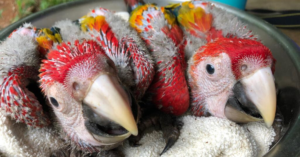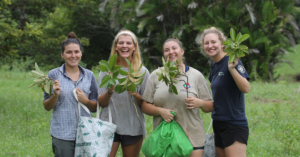

The regular 5 am macaw vocalizations echo throughout the Punta Islita valley, marking the start of another busy day at Macaw Recovery Network’s Captive Breeding Center in Costa Rica. The team slowly wakes and prepares for the long day ahead, which begins by cleaning food dishes and preparing diets for the 100+ Scarlet and Great Green Macaws who eagerly await their breakfast. Always willing to sacrifice, the team will wait to have their breakfast until the birds are tended to. This is a glimpse of the many things our team does in order to increase the number of macaws flying free and ensure their future existence on this planet.
I’ve been a part of MRN’s captive breeding team for over 2 years now. The work is long and hard but motivated by the desire to make a positive impact on the future of these impressive birds. We rely heavily on passionate volunteers to make this possible, as well as the skills and dedication of many Costa Ricans who work with us. Our efforts here are necessary, because though once numerous throughout Central and South America, the threatened Scarlet Macaw (Ara macao) and the endangered Great Green Macaw (Ara ambiguus) have been reduced to a fraction of their historical numbers. This is due to selective logging, stealing chicks from their nests for the pet trade, and loss of healthy forests. With their populations facing such serious threats, one management strategy we utilize is captive breeding-for-release.

After the team has seen to the morning needs of the birds, which includes performing visual health checks, they take a few minutes to prepare for the day ahead. The tasks that await their attention vary seasonally, not to mention daily and even hourly. Some things remain consistent year-round, which include, cleaning, providing enrichment, maintenance, fecal screening, health and behavior observations, and a variety of data collection.
Currently, we are finishing up a very successful breeding season, which occurs annually from December – July. This is Costa Rica’s dry season and the time of year that most birds are naturally breeding. The higher availability of food is one factor. We’ve had a record number of chicks to hatch and fledge this season and, as we’d hoped, all of them have been parent-raised! Our goal is to leave all hatching and rearing to the parents, so we remain as distant as possible in the process, only stepping in to provide aid should a chick or egg need it. Monitoring the health and growth of these precious chicks takes a lot of time and these tasks combined with others specific to the breeding season keep our team very busy.

Before a successful breeding season can happen, our team spends nearly every day in the rain and mud of the non-breeding season (August – November) focusing on things such as aviary construction, maintenance, weekly deep cleanings, nest box construction and installation, camera, and temperature gauge installation and the never-ending task of “furnishing” the aviaries with perching, fresh plants, and other enrichment items. It seems the work will never let up, and then, at last, the rains begin to subside and the sun returns in full.
At the start of December, much-needed reinforcements arrive in the form of our Apprentices, who help the staff to monitor the captive birds’ breeding success while learning about conservation management over the course of 8 months. Their arrival brings extra aid to the team that has spent the previous four months trudging through the rainy season and its demands. The change in seasons, though welcome, also brings a new crop of challenges and expectations.
With the sudden decrease in rain, the Great Green Macaws are suddenly in an environment that is drastically different from the environment of their wild counterparts. Great Greens have historically chosen to live in the Caribbean lowland side of Costa Rica. There, the rainfall and humidity are high even into the dry season. Meanwhile, our Captive Breeding Center is located on the Nicoya Peninsula, which is much dryer. Aware that the conditions between the two sites are very different, we do our best to create an artificial “rainforest” within our means. We’ve installed overhead showers on all of our aviaries, which are turned on daily for 30 minutes at a time to increase the humidity, cool the environment, and allow the birds a chance to bathe.

In addition to the environmental changes we must artificially manage, we also closely manage the birds’ diets to reflect their seasonal needs and ensure they are receiving enough energy and nutrients to successfully breed. Our team not only prepare the diets twice daily to order (each bird has its own likes and dislikes) but also cater to the stage of reproduction they are in. A bird with one young chick receives a diet very different to one raising 3 older chicks! One way we supplement their diets is to forage for naturally occurring foods in the area. This includes beach almonds, palm fruits, nance, and a variety of other tasty treats. These food items provide additional key nutrients as well as play an important cognitive role. The chicks watch their parents eat these food items and learn how to crack them open through observation and practice. By providing our pre-release birds with these food items, we increase their chance of survival post-release.
Once we’ve established a flock of young birds that we hope to release, careful observations of each individual must be done over a period of time and repeated before we can approve their release. If we notice any unfavorable behaviors, we come up with a plan to decrease them and increase favorable ones. Some behavioral issues are easier to solve than others, but we make every attempt to increase their scores. The basic things we are looking for are that the individual is in good health (disease-free and physically fit), has the ability to socialize, fly, avoid predators, and expresses behaviors normal for its species. We’ve yet to see any of our pre-release birds wandering across the ground saying “Hola” to a rubber snake, so we must be doing something right!

In the end, everything we do at the captive breeding center throughout the entire year is done with one goal in mind: to breed healthy macaws for release back into their native habitats. The how and when is something that we are constantly striving to improve, and it’s only through the support of our volunteers, partners, and input from other professionals that we are successful. Until these birds are able to fly free, the team at the breeding center will continue to rise with the sun to care for them, working towards a future where macaws are independently thriving across Costa Rica again.
Brittany Decker: Programs Manager – Captive Breeding Center